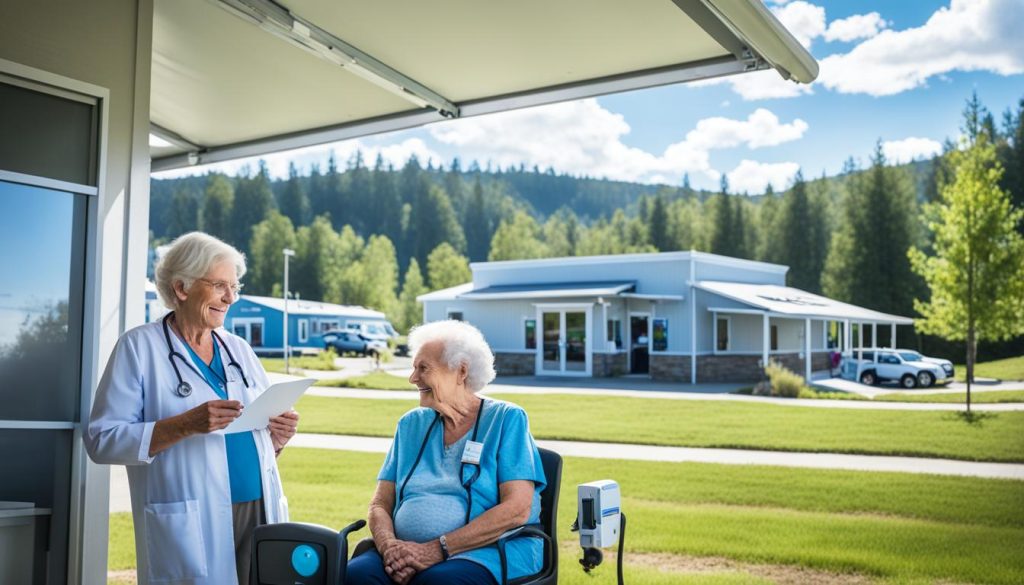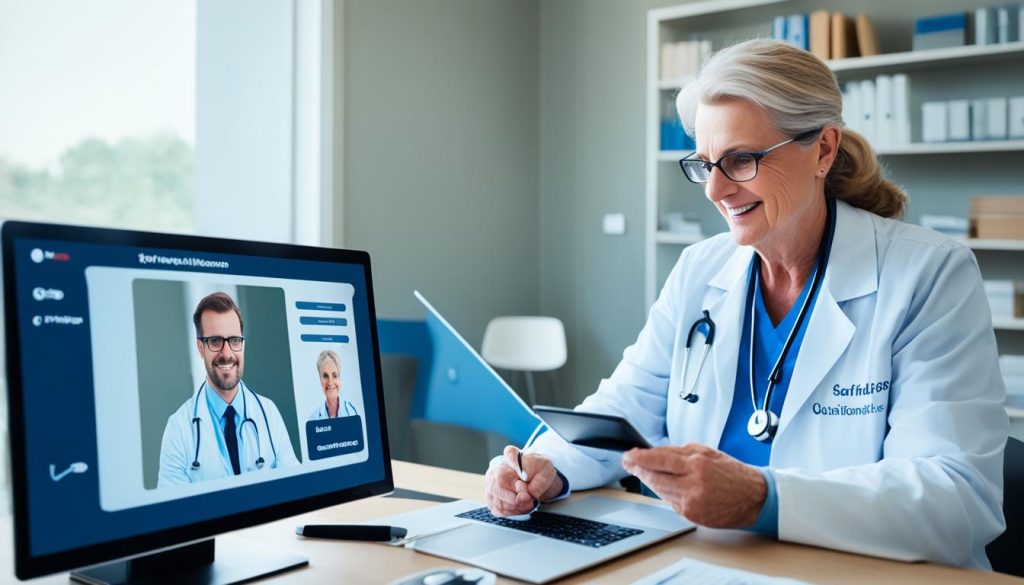Did you know over 20% of the US lives in rural areas? This is a big number.
Getting to a doctor when you live far away is hard. There are not many clinics around and often, you must travel a long way. But, things are improving with telehealth. This technology is changing how healthcare reaches those in the toughest to get to places.
With telemedicine, you can see a doctor online. This lets people in rural areas get check-ups and other health help. They can do this without leaving home.
Key Takeaways:
- Over 20% of the US population lives in rural areas.
- Accessing healthcare in remote locations is challenging due to limited availability and long travel distances.
- Telemedicine provides virtual access to healthcare providers and a range of digital health services.
- Remote telemedicine allows individuals in remote areas to receive prompt and quality healthcare.
- Telehealth technology is revolutionizing healthcare delivery in rural communities.
Addressing the Gap in Diabetes Self-Management Education and Support (DSMES) Services in Rural Areas
In the United States, rural areas have more people dealing with diabetes. However, these places have fewer diabetes self-management education and support (DSMES) services. These services are key in helping people control their diabetes well.
Telehealth steps in as a great way to tackle this problem in rural spots. It allows those living far away to get the help and resources they need for their diabetes. This technology breaks down the distance and time barriers. So, it’s easier for people in rural areas to join in DSMES programs.
“Telehealth has the potential to bridge the gap in diabetes self-management education and support services for individuals living in rural areas. Through remote consultations and digital resources, individuals can access the education and support they need to effectively manage their diabetes.” – Dr. Jane Thompson, Endocrinologist
The Centers for Disease Control and Prevention (CDC) offers a helpful guide. It’s for groups wanting to provide DSMES through telehealth. This guide gives tips and things to think about when setting up telehealth for DSMES.
Benefits of Telehealth for Diabetes Self-Management Education and Support
- Improved accessibility: It makes DSMES available to rural folk without them needing to visit in person. This is a big deal for those with travel issues and few local services.
- Convenient and flexible: With telehealth, people can learn and get help from home. They don’t have to worry about long journeys or time away from work or family.
- Better adherence: Telehealth lets doctors check in more often and help with sticking to diabetes plans. This usually leads to better health in the end.
- Increased engagement: The online tools and games on telehealth platforms really hook people in. They start taking more control over their health, which is great for managing diabetes.
The Role of Telehealth in Improving Rural Healthcare Access and Quality
Telehealth is changing the game for rural healthcare. It uses technology to improve how people in the countryside get medical help. This is key, as rural areas often lack easy access to specialists and have transport problems. By using telehealth, doctors can support patients from afar, making healthcare both better and cheaper.
Telehealth helps rural patients get care without making long trips. This is big because it breaks down the distance barriers. It means anyone out in the sticks can easily see a doctor or specialist online. All they need is their computer or phone. This way, people save time and money by avoiding long journeys.
Moreover, telehealth boosts the quality of healthcare in the country. It lets doctors and specialists work together closely, even if they’re miles apart. They can share tips, data, and plans for best patient care. This teamwork leads to smarter decisions and, in the end, healthier patients.
Expanded Healthcare Services
Telehealth brings more types of healthcare right to rural doorsteps. It covers everything from heart health to skin checks and mental wellness. Thanks to these online services, folks don’t need to travel far for most medical needs. So, they get care nearby, which is a big win.
Also, technology keeps rural doctors up-to-date from where they live. They can join classes and training online without heading off. This keeps their skills fresh and their practice top-notch. So, rural folks enjoy better healthcare, thanks to well-trained, local experts.
Overall, telehealth is a game-changer for healthcare out in the country. It helps close the gap between rural folks and top-notch healthcare. With it, people in remote areas find it easier to get the care they need. And the care they get is just as good as what city folks have, if not better.
Stay tuned for Section 4, where we will explore the impact of telehealth technology on rural healthcare providers and facilities.
The Impact of Telehealth Technology on Rural Healthcare Providers and Facilities
Telehealth technology is changing how healthcare is given in the countryside. It’s improving the way rural healthcare providers and facilities work. Communities are also feeling the effects.
Rural providers can now give more specialized services without their patients having to travel far. This changes the game, helping people get expert care without the long trips.
One big benefit is reducing the number of patients that have to travel out for care. This makes things a lot easier for both patients and the rural healthcare facilities. Now, local care can be top-notch, with better services and results for the patients.
But there are hurdles in making telehealth work in the country. One major issue is the lack of skilled workers who know how to use telehealth tech. To really make the most of telehealth, rural healthcare places must train their staff well. They need to be pros at using telehealth tools.
Getting paid is another problem for rural providers using telehealth. Though telehealth is seeing more use, how providers get paid can be different and difficult. Solving these payment problems is key to keeping telehealth going in the countryside.
Also, technology issues like slow internet and old systems are common in rural spots. These can make using telehealth hard. So, fixing these tech problems and boosting internet in the country is crucial for telehealth to work well.
Even with all these problems, telehealth is set to change rural healthcare. It makes talking with healthcare providers easier. It also makes it simpler to get special care, leading to better healthcare results for people living in the country.
Telehealth helps rural healthcare providers beat the challenges of distance. Now, they can offer more services without patients needing to travel far or leave their communities. This way, expert care comes right to the people.
The Importance of Health Information Technology (HIT) in Rural Healthcare
Getting quality healthcare in rural places can be hard. Health Information Technology (HIT) helps solve this. It improves health results and access to care in the countryside.
HIT lets patients be more aware of their health. It gives them easy access to their health info. This helps them make better choices and be more involved in their treatment.
Also, HIT makes health services work better. It uses new tech to cut down on paperwork and make less mistakes. This gives healthcare workers more time to look after patients.
“Health Information Technology can change how rural healthcare works. It connects rural and city care, making good care more reachable.” – Dr. Emily Johnson, Rural Healthcare Specialist
HIT is also key for checking and sharing health quality info. This is vital for new payment models that pay for good results. It helps rural health places give better care and get more money for it.
Plus, HIT with telehealth is great for keeping track of health. These services help doctors watch over patients from afar. This means quick help when needed and fewer trips to the hospital.
Using HIT, rural healthcare places can better care for patients and improve their health. It leads to better care all around.
The Benefits of Health Information Technology (HIT) in Rural Healthcare:
- Enhanced patient engagement and empowerment through easy access to health info
- Fewer tasks and less paperwork, making things work better
- Maintaining good care records to get more payment for better care
- Better follow-ups, faster care when needed, and clearer communication with telehealth
Bringing HIT into rural healthcare needs a lot of thought and work. But, it’s worth it in the long run. HIT helps bring rural and city healthcare closer in care and quality.
| Advantages of Health Information Technology (HIT) | Challenges |
|---|---|
| Enhanced patient engagement | Limited access to technology infrastructure in rural areas |
| Efficiency improvements and reduced paperwork | Resistance to change and adoption of new technologies |
| Accurate tracking and reporting of quality data | Costs associated with implementing and maintaining HIT systems |
| Improved monitoring and timely interventions | Lack of interoperability between different HIT systems |
There are challenges, but HIT is very important in rural healthcare. With new tech and HIT, healthcare workers can give rural people quality care like in cities.
Equipment and Technology Requirements for Rural Telehealth
To start a rural telehealth practice, you need the right equipment and tech. With the right tools, healthcare workers can offer great care in places far from cities. This improves how people can get health services and their health results.
Computers and Software: Every provider should have highly reliable computers. They need the right software for health records and patient portals. This makes taking and sharing notes, and looking at patient histories, much easier.
Communication Tools: Good communication is key in telehealth. It’s important to have tools like secure messaging, phones, and video chat. Laptops or devices with cameras are important for video calls. They let healthcare providers see their patients and connect closely.
Data Management: Using special programs is important. These programs look after data from health gadgets at home. They let providers check up on patients, gather data, and take the best care steps. It’s also key for doctors to share big files or images easily when talking online.
Connectivity: Fast, reliable internet is a must. It lets telehealth work well, with smooth video and easy data sharing. In places with weak internet, using phones connected to the line can help keep in touch.
Telehealth in rural areas also means using phones, texts, and secure messaging, depending on what’s needed. This flexibility helps meet the unique needs of different health practices and their patients.
By using the right equipment and tech, telehealth can truly improve healthcare in rural areas. It closes gaps in access, boosts local quality care, and helps everyone in these remote places be healthier.
Conclusion
Telemedicine and remote healthcare are crucial for filling healthcare gaps in faraway places, especially in rural areas. These services provide quick virtual care. This means people can get the help they need without long trips.
With telehealth and health info technology, healthcare gets better in rural areas. Platforms let more patients get services. It also means healthcare pros can work together better.
As tech gets better, remote telemedicine will become even more important. It connects rural areas to better healthcare. This means people get care on time and at high quality.
To wrap up, telemedicine and remote healthcare change how we bring care to far-off places. By using these digital tools, healthcare can reach those who need it most. It improves healthcare and the lives of people in remote areas.


